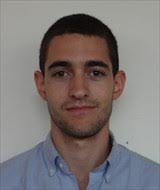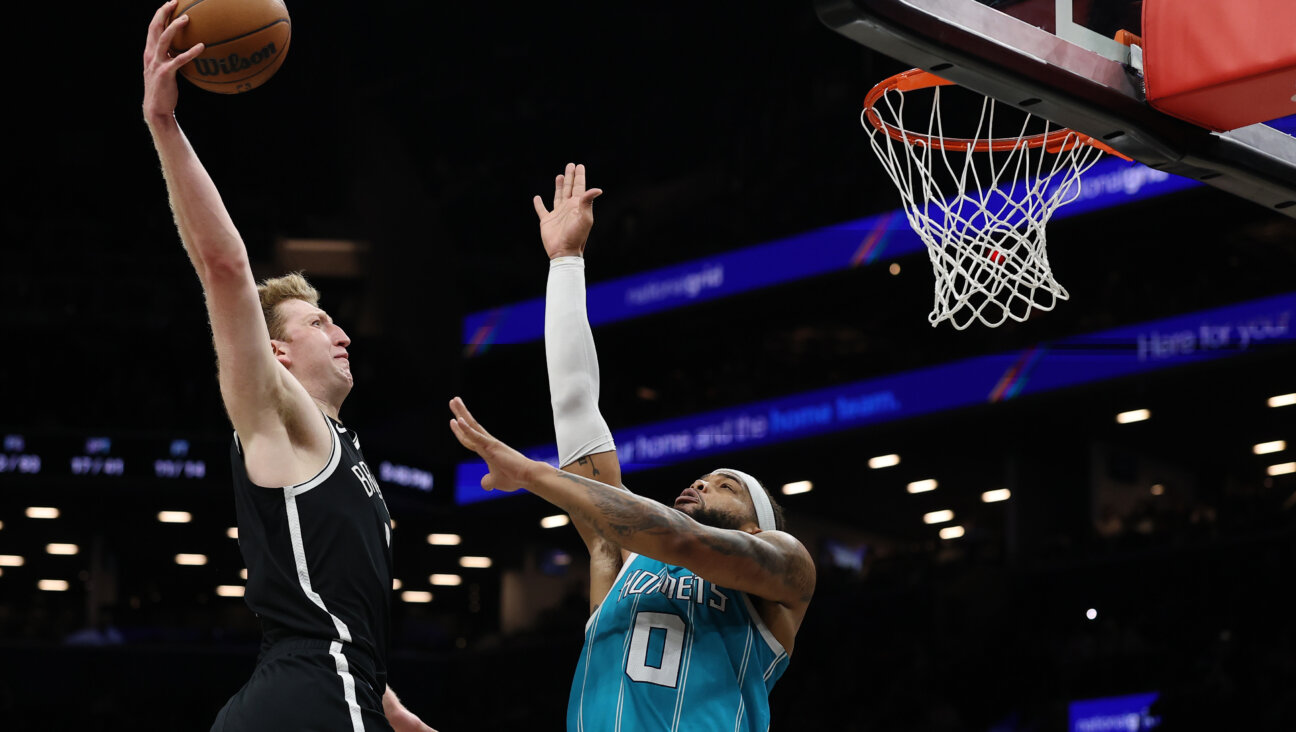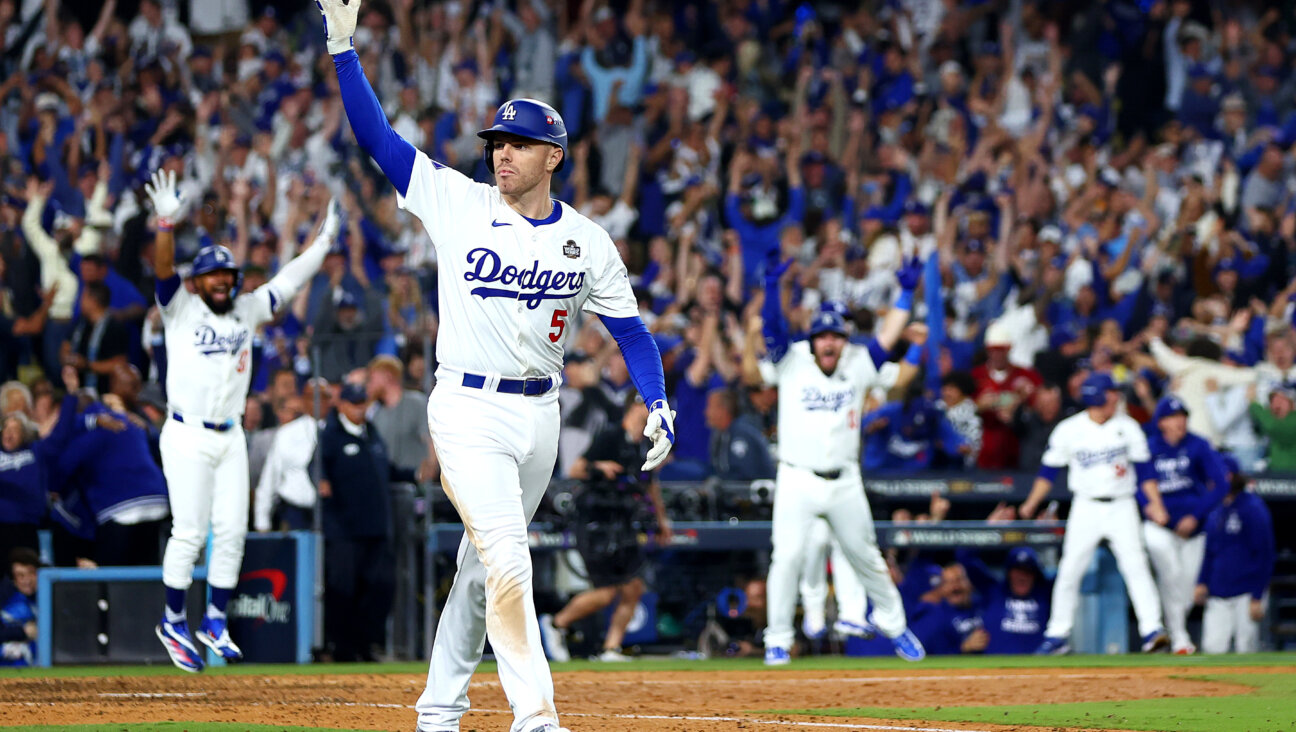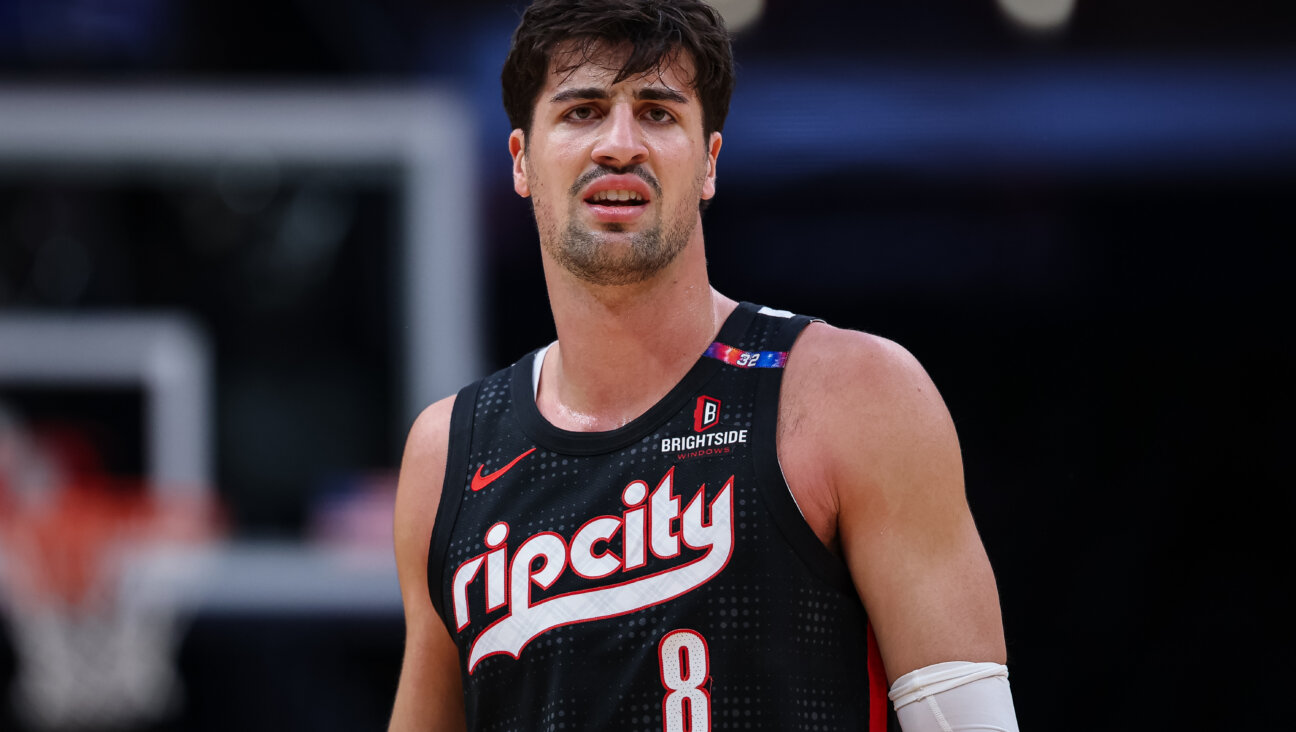How LA’s Jewish high schools became NBA summer hotspots
A sanctuary for superstars and a brush of fame for hoops-obsessed high schoolers
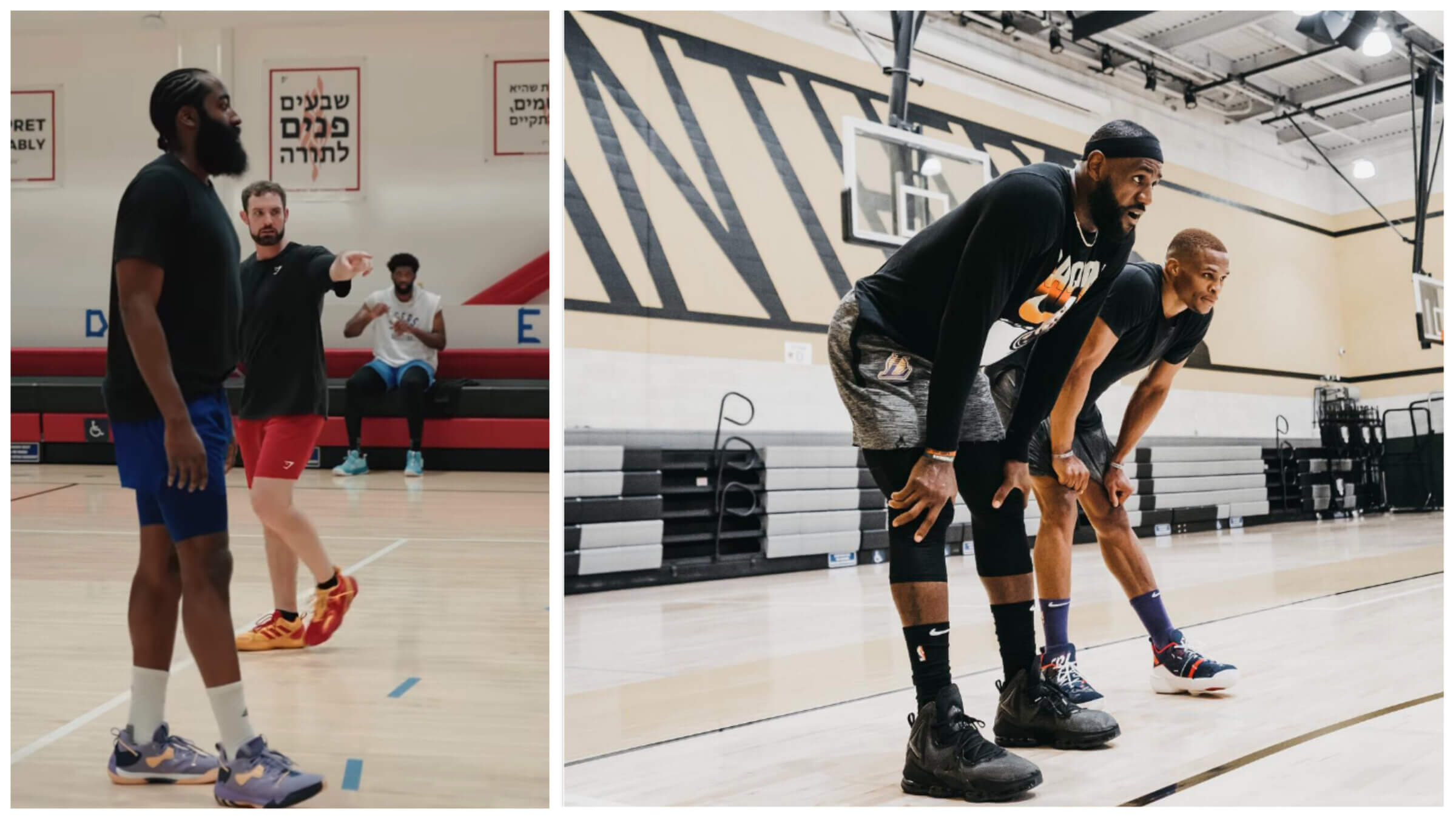
Left: James Harden awaits instruction from Drew Hanlen as Joel Embiid (background) takes a water break at Shalhevet. Right: LeBron James and Russell Westbrook in the YULA gym in summer 2021. (Both photos via Instagram.) Image by Louis Keene
For fans of the NBA, getting a peek at players honing their craft has become a cherished offseason treat. But there’s been an extra surprise lately for fans who read right-to-left: Several pros — including a few of the league’s best — have been practicing at Jewish high schools.
What was once a closely guarded secret has lately become hard to miss. In one clip recently posted to Instagram, the Philadelphia 76ers’ James Harden — he of the beard that could make a Breslover blush — awaits a pass with a Hebrew poster behind him that quotes Midrash. In the background of the same shot, his teammate Joel Embiid — the MVP runner-up (and Jewish wedding show-stealer) — hydrates under an adage from Pirkei Avot.
The context clues — and the black-and-red color theme — give the location away. That’s Shalhevet, an Orthodox school in Los Angeles whose basketball gym is also the site of weekly school assemblies. (Hence the posters.)
A couple miles away and 11 months earlier, Laker superstars LeBron James and Russell Westbrook were spotted working out in the black and yellow-adorned Samson Center — the gym belonging to Yeshiva University of Los Angeles Boys High School, known as YULA. Dejounte Murray posted pictures from the Samson Center to his Instagram story in June.
The presence of marquee ballers at these schools is one downstream effect of — and a rich reward for — a passion for basketball in the Orthodox world that some might say borders on obsession. Both schools — which are athletic rivals, to say nothing of admissions — opened these million-dollar gyms in the last decade. Shalhevet draws Jewish schools from across the country to theirs for an annual tournament (whose banners can be seen in the background of some NBAers’ photos). And though you’ll never read it in the schools’ brochures, their top-quality courts now mean a possible brush with fame for high school kids who regard these players as larger than life.
What’s the draw of hardwood courts with Jewish wisdom on the walls? In addition to being relatively new, they’re well-maintained, available, and — crucially, for some of the most famous people on the planet — private. That means no kids peering through the windows, let alone ducking in for autographs.
“They’re looking for somewhere very, very quiet, secluded, safe,” said Rabbi Ari Segal, Shalhevet’s former head of school.
At Shalhevet, where players pour into the gym most weekdays this time of year, the shidduch was made a few years ago by a student then interning for Drew Hanlen, a hotly demanded private skills trainer. Hanlen now uses the school as his lab for a client roster that includes Embiid, Harden and Celtics swingman Jayson Tatum, as well as the league’s only Jewish player, Deni Avdija.
At YULA, the arrangement was originally facilitated by an alum — who said he could not comment due to a nondisclosure agreement. (YULA’s head of school also declined to comment.)
Despite (or perhaps because of) the supposed secrecy of the workouts, videos that emerge from them are some of the most popular content of the NBA offseason. It was inevitable, then, that each school’s gym would be the stage of its own viral moment.
During a 2019 pickup game at YULA that involved several NBA stars, Devin Booker, a quicksilver guard for the Phoenix Suns, protested being double-teamed. Video of the exchange was posted online, igniting a debate throughout the NBA world that remains unsettled.
Shalhevet’s biggest splash came from a 5-on-5 scrimmage that featured not only perennial all-stars Bradley Beal, Carmelo Anthony and Trae Young, but also the rapper 2 Chainz. That’s just the tip of the iceberg of top-shelf ballers who frequent Shalhevet: Zach Lavine, Tyrese Haliburton, RJ Barrett, Tyler Herro — the list goes on.
“This is the best of the best,” Segal said. “I mean, it was weird, actually, how small we are, and the size of our gym even, that they were scrimmaging there, but they were scrimmaging there.”
Never miss a West Coast story. Sign up for the Forward’s California Briefing for weekly links to Jewish news, culture, and life in the Golden State.
NBA players playing ball at Shalhevet predate Hanlen, who Segal said pays a nominal rental fee for use of the gym. In fact, the phenomenon is as old as the gym itself. Dunk-contest winner Blake Griffin was the first person to use it when it opened in 2015, reportedly calling the facility “amazing” in a video produced by the school.
(Speaking of dunking: “I have cringed a couple of times when some guys have thrown down dunks,” said Ryan Coleman, the school’s athletic director and basketball coach. Last summer, he recalled, RJ Barrett — that is, the New York Knicks’ franchise cornerstone — slammed one so hard “I thought honestly the entire basket was going to come down.” It survived.)
About half of the slogans on the wall of the Shalhevet gym are in Hebrew, making them unintelligible for all but one of Hanlen’s players: the Israeli Avdija, a forward for the Washington Wizards entering his third NBA season. One Hebrew sign quotes the maxim, “If you will it, it is no dream,” attributed to Theodor Herzl, the father of modern Zionism.
According to Segal, a rabbi who crossed paths with Avdija in the hallway asked him if he’d noticed it. Avdija replied something along the lines of, “You don’t know how amazing it is to work out with the Israeli flag hanging in the gym.”
I went to high school here. https://t.co/EUyZMbPRfE
— Louis Keene (@thislouis) July 22, 2022
Though they’re forbidden from sitting in on the workouts — Harden and Embiid are particularly sensitive to uninvited spectators — Shalhevet students do occasionally benefit from their proximity. A few have scored selfies, others memorabilia. The players have also autographed jerseys for the school to auction off.
Aiden Bitran, a rising sophomore at Shalhevet and a point guard on the school’s basketball team, was unaware of the NBA greats practicing behind the locked gym doors until he caught a glimpse of Beal and his favorite player, UCLA freshman Amari Bailey, getting shots up through a crack in the window.
“I was going crazy,” Bitran, 15, said. “My friends were like, ‘Yo, you gotta chill.’”
Segal, now Shalhevet’s chief strategy officer, said the friendliness of Hanlen’s flock has been consistent — even if the guys can be harsh on the rims.
Last year, with the NBA offseason coming to the end around the same time as Shalhevet orientation, Segal asked Hanlen if he would send a few players to meet the kids at a school barbecue. A bunch went, including Tatum and Beal, who signed a $251 million contract with the Washington Wizards this summer.
It was then that Bitran got his chance to meet Bailey — a player he says he patterns his game after.
During their hourlong conversation, Bailey, who has more than 500,000 Instagram followers, hangs out with Drake and is considered a likely first-round pick in next year’s NBA Draft, had a surprising reveal for Bitran and his friends: He’s Jewish, too.
“He told us his mom is Jewish,” Bitran said. “He’s like, ‘Yeah, I got one of those kippahs that you guys are wearing at home, bruh.’ I’m like ‘Oh, that’s cool.’ It actually was really cool.”
On a different day, he slipped into the gym and spotted Tatum, who made the NBA Finals with the Celtics last season, taking a water break in the bleachers.
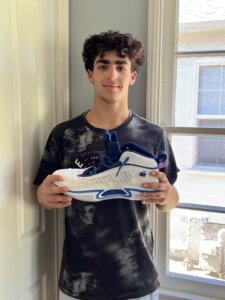
He introduced himself to Tatum and asked him if he could have the player’s custom Jordan brand bracelet. Tatum said he couldn’t give him that — but he was willing to part with his sneakers. Now Tatum’s size-15 shoe sits on a shelf in Bitran’s room.
Another player, the Charlotte Hornets’ Kelly Oubre, offered more resistance at first.
“I’m like ‘Yo, Oubre, can I get your shoe?’” Bitran said. “He’s like, ‘Umm, do you deserve it?’”
His winning response: “Yeah, bro. I work hard in school.”
Yet to Bitran, who aspires to play college basketball, the sweetest benefit hasn’t been the footwear, but the few minutes each day when the end of Shalhevet’s 5:30 a.m. basketball practices overlap with Hanlen’s crew’s warmups.
He’s paid close attention to the habits and routines of the sport’s elite in those fleeting moments.
“If I really want to be great one day at what I do, I have to work hard,” he said. “And just watching them work out and seeing what they do, it’s just rep after rep after rep of the same thing, over and over again.”
